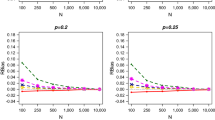Abstract
Population size estimation is an important research field in biological sciences. In practice, covariates are often measured upon capture on individuals sampled from the population. However, some biological measurements, such as body weight, may vary over time within a subject’s capture history. This can be treated as a population size estimation problem in the presence of covariate measurement error. We show that if the unobserved true covariate and measurement error are both normally distributed, then a naïve estimator without taking into account measurement error will under-estimate the population size. We then develop new methods to correct for the effect of measurement errors. In particular, we present a conditional score and a nonparametric corrected score approach that are both consistent for population size estimation. Importantly, the proposed approaches do not require the distribution assumption on the true covariates; furthermore, the latter does not require normality assumptions on the measurement errors. This is highly relevant in biological applications, as the distribution of covariates is often non-normal or unknown. We investigate finite sample performance of the new estimators via extensive simulated studies. The methods are applied to real data from a capture–recapture study. Supplementary materials accompanying this paper appear on-line.


Similar content being viewed by others
References
Alho JM, Mulry MH, Wurdeman K, Kim J (1993) Estimating heterogeneity in the probabilities of enumeration for dual-system estimation. J Am Stat Assoc 88:1130–1136
Carroll RJ, Ruppert D, Stefanski LA, Crainiceanu CM (2006) measurement error in nonlinear models: a modern perspective, 2nd edn. Chapman and Hall, London
Chao A (2001) An overview of closed capture–recapture models. J Agric Biol Environ Stat 6:158–175
Hansen MH, Hurwitz WN (1943) On the theory of sampling from finite populations. Ann Math Stat 14:333–362
Huang Y (2014) Corrected score with sizable covariate measurement error: pathology and remedy. Stat Sin 24:357–374
Huang Y, Wang CY (2000) Cox regression with accurate covariates unascertainable: a nonparametric-correction approach. J Am Stat Assoc 95:1209–1219
Huang Y, Wang CY (2001) Consistent functional methods for logistic regression with errors in covariates. J Am Stat Assoc 96:1469–1482
Huang YH, Hwang WH, Chen FY (2011) Differential measurement errors in zero-truncated regression models for count data. Biometrics 67:1471–1480
Huggins RM (1989) On the statistical analysis of capture experiments. Biometrika 76:133–140
Huggins R, Hwang WH (2010) A measurement error model for heterogeneous capture probabilities in mark-recapture experiments: an estimating equation approach. J Agric Biol Environ Stat 15:198–208
Hwang WH, Huang SYH (2003) Estimation in capture–recapture models when covariates are subject to measurement errors. Biometrics 59:1113–1122
Hwang WH, Huang SYH (2007) Measurement errors in continuous-time capture–recapture models. J Stat Plan Inference 137:1888–1899
Hwang WH, Huggins R (2005) An examination of the effect of heterogeneity on the estimation of population size using capture–recapture data. Biometrika 92:229–233
Hwang WH, Huang SYH, Wang CY (2007) Effects of measurement error and conditional score estimation in capture–recapture models. Stat Sin 17:301–316
Hwang WH, Heinze D, Stoklosa J (2019) A weighted partial likelihood approach for zero-truncated models. Biometric J 61:1073–1087
Liu Y, Li P, Qin J (2017) Maximum empirical likelihood estimation for abundance in a closed population from capture–recapture data. Biometrika 104:527–543
Liu Y, Liu Y, Li P, Qin J (2018) Full likelihood inference for abundance from continuous time capture–recapture data. J R Stat Soc Ser B 80:995–1014
McCrea RS, Morgan BJ (2015) Analysis of capture–recapture data. Chapman and Hall/CRC Press
Nakamura T (1990) Corrected score function for errors-in-variables models: methodology and application to generalized linear models. Biometrika 77:127–137
Pollock KH (2002) The use of auxiliary variables in capture–recapture modelling: an overview. J Appl Stat 29:85–102
Schofield MR, Barker RJ, Gelling N (2018) Continuous-time capture–recapture in closed populations. Biometrics 74:626–635
Stefanski LA (1989) Unbiased estimation of a nonlinear function a normal mean with application to measurement error models. Commun Stat Ser A Theory Methods 18:4335–4358
Stefanski LA, Carroll RJ (1987) Conditional scores and optimal scores for generalized linear measurement-error models. Biometrika 74:703–716
Stoklosa J, Hwang WH, Wu SH, Huggins RM (2011) Heterogeneous capture–recapture models with covariates: a partial likelihood approach for closed populations. Biometrics 67:1659–1665
Stoklosa J, Lee SM, Hwang WH (2019) Closed-population capture–recapture models with measurement error and missing observations in covariates. Stat Sin 29:589–610
Van der Heijden PGM, Cruyff MJLF, Van Houwelingen HC (2003) Estimating the size of a criminal population from police records using the truncated Poisson regression model. Stat Neerland 57:1–16
Wilson KR, Anderson DR (1995) Continuous-time capture–recapture population estimation when capture probabilities vary over time. Environ Ecol Stat 2:55–69
Xi L, Watson R, Wang JP, Yip PSF (2009) Estimation in capture–recapture models when covariates are subject to measurement errors and missing data. Can J Stat 37:645–658
Xu K, Ma Y (2014) Effective use of multiple error-prone covariate measurements in capture–recapture models. Stat Sin 24:1529–1546
Yip PSF, Lin HZ, Xi L (2005) A semiparametric method for estimating population size for capture–recapture experiment with random covariates in continuous time. Biometrics 61:1085–1092
Zhang W, Bonner SJ (2020) On continuous-time capture–recapture in closed populations. Biometrics 76:1028–1033
Acknowledgements
The authors are grateful to an associate editor and two referees for reviewing the manuscript and providing valuable comments. This work was supported by the Ministry of Science and Technology of Taiwan (Hwang), US National Institutes of Health Grants CA235122, CA239168, CA86368, and ORIP S10OD028685 (Wang).
Author information
Authors and Affiliations
Corresponding author
Additional information
Publisher's Note
Springer Nature remains neutral with regard to jurisdictional claims in published maps and institutional affiliations.
Supplementary Information
Below is the link to the electronic supplementary material.
Rights and permissions
About this article
Cite this article
Hwang, WH., Stoklosa, J. & Wang, CY. Population Size Estimation Using Zero-Truncated Poisson Regression with Measurement Error. JABES 27, 303–320 (2022). https://doi.org/10.1007/s13253-021-00481-z
Received:
Revised:
Accepted:
Published:
Issue Date:
DOI: https://doi.org/10.1007/s13253-021-00481-z




